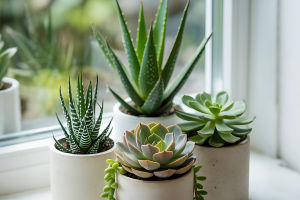Plants are some of the most adaptable organisms on Earth, and certain species have developed remarkable ways to thrive in environments that seem inhospitable to most life forms.
From the arid deserts to icy tundras, some plants can survive in extreme temperatures, dryness, and even the harshest chemical conditions.
These "survivalists" defy the conventional limits of what we consider habitable and offer insights into the incredible resilience of nature. Let's explore some of these remarkable plants and learn how they manage to survive where most life would struggle.
Desert Survivors: Plants of Extreme Heat and Drought
When you think of extreme environments, deserts likely come to mind. These areas are notorious for their scorching temperatures and scarce water supply, yet they are home to some of the most resilient plants in the world. One of the best-known examples is the cactus, particularly species like the Saguaro and the Barrel Cactus.
Cacti have evolved several ingenious adaptations that allow them to thrive in dry, arid conditions. Their thick, waxy skin prevents water loss, and their roots are wide and shallow, allowing them to absorb as much water as possible during infrequent rainfalls. The Saguaro cactus, for instance, can store up to 200 gallons of water in its tissues, which helps it survive for long periods without rain.
Life in the Arctic: Plants That Endure Freezing Temperatures
While deserts are hot and dry, the Arctic is the opposite—cold and frozen. Yet, even here, certain plants manage to survive the harsh winters. The Arctic Willow, for example, is a small shrub that grows in the frozen tundra. It thrives in temperatures as low as -40°F (-40°C) by staying close to the ground, where it is shielded from the most extreme cold.
One of the most fascinating survival strategies of Arctic plants is their ability to go into a state of dormancy during the winter months. Instead of trying to grow and flower in the dead of winter, these plants slow down their metabolic processes and conserve energy, essentially waiting for the warmer spring temperatures to kickstart growth. Many of these plants, like mosses and lichens, can even survive being frozen for months and thawing out when the weather warms.
Adaptations to Extreme Salt: Plants of Saline Environments
Some environments are harsh not because of temperature, but because of the chemicals in the soil. Halophytes are plants that have evolved to survive in areas where the soil is too salty for most other organisms. These include the Glasswort and Salicornia, often found in coastal regions or salt marshes.
Halophytes have developed unique mechanisms to tolerate high concentrations of salt in their tissues. Some can secrete salt through special glands in their leaves, while others store the salt in vacuoles, preventing the plant from being poisoned by the excessive salt. These plants are not just survivors—they have adapted so well to saline environments that they have become crucial to coastal ecosystems, preventing soil erosion and supporting diverse animal species.
Survival in Extreme Altitudes: Plants That Thrive at the Top of the World
At extreme altitudes, conditions are not only cold, but the air is thin, with less oxygen and lower atmospheric pressure. Yet, some plants still manage to survive at these heights. In the Himalayas and the Andes, Alpine Plants like the Edelweiss and Andean Lupine grow in conditions where most life would suffocate.
To survive at high altitudes, these plants have adapted to make the most of the available sunlight, despite the thinner atmosphere. Many alpine plants have small, hairy leaves that help trap heat from the sun, and their roots spread widely in search of water and nutrients. These plants also tend to be low-growing to avoid the strong winds that could easily damage or dry them out.
Extreme Heat and Cold: The Resilience of the Welwitschia
Perhaps one of the most astonishing examples of plant resilience comes from the Welwitschia, a plant native to the deserts of Namibia and Angola in Africa. This plant is known for its bizarre appearance—only two long, leathery leaves grow from its stem over its entire lifespan. Despite its unusual shape, the Welwitschia is an extraordinary survivor, able to withstand extreme desert conditions, including temperatures that can reach 122°F (50°C).
The Welwitschia can survive with very little water, thanks to deep taproots that reach underground water sources. This plant can even endure up to five years without any rain. It's a true marvel of desert adaptation.
How Plants Adapt: The Science Behind Their Survival Strategies
Understanding how these plants survive requires a look at their unique biological mechanisms. Some, like the Desert Fig and Cacti, are able to store water in their tissues, swelling like sponges during rare rainfall. Others, such as the Arctic Moss, produce chemicals that prevent the formation of ice crystals in their cells, essentially acting as natural antifreeze.
Additionally, many of these plants have evolved specialized root systems to seek out water and nutrients in the most difficult environments. Whether through the wide, shallow roots of desert plants or the deep, taproots of alpine species, their roots are vital to their survival in extreme conditions.
Conclusion: The Magic of Nature's Resilience
The ability of plants to survive and thrive in extreme environments is nothing short of magical. From the deserts to the icy tundra, and from the high mountain tops to saline shores, plants have developed extraordinary survival strategies that allow them to conquer some of the harshest conditions on Earth. These plants not only survive—they flourish in conditions that would challenge even the hardiest of animals.
By studying these resilient plants, we gain not only a greater appreciation for nature's adaptability, but also insights into how we might use their strategies to improve human survival in challenging environments. Whether it's in agriculture, climate adaptation, or ecosystem conservation, the extraordinary plants that thrive in extreme conditions may hold the key to a more sustainable future.


